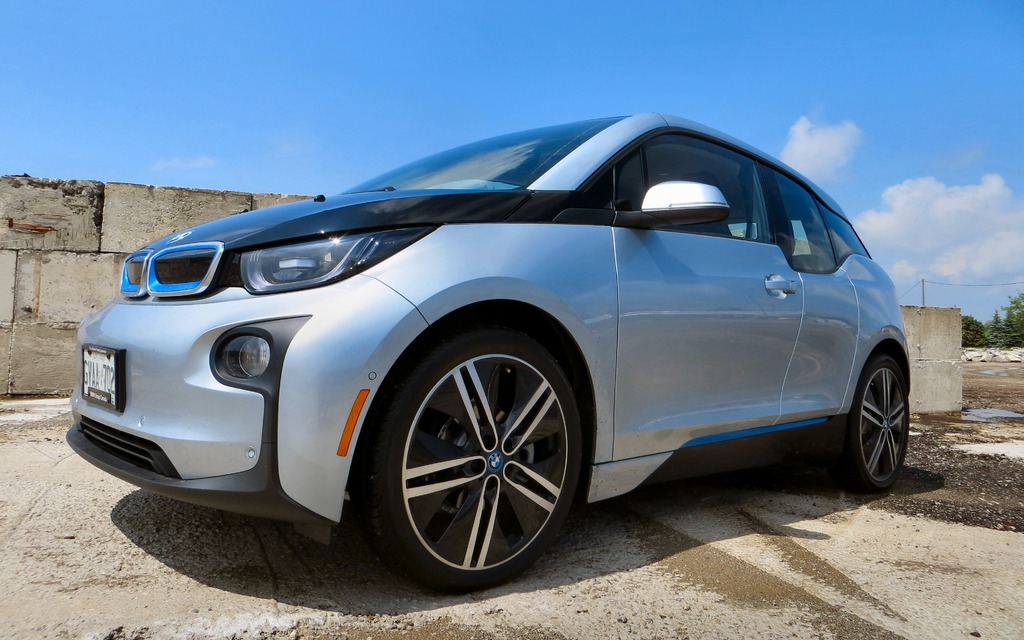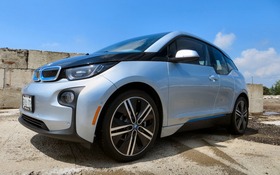2014 BMW i3: Tomorrow's Sounds (Of Silence) Today

| Strong points |
|
|---|---|
| Weak points |
|
Electric cars have passed the tipping point between curiosity and genuine market force here in Canada, and perhaps no vehicle illustrates that point better than the 2014 BMW i3. Canada's relationship with battery-powered automobiles is an intricate one that takes into account our typically affordable electrical rates, our battery-killing cold winter climate, and our desire as a nation to somehow escape the high price of gasoline.
The 2014 BMW i3 is no novelty or toy for the rich set. It's a real-world option for thousands of Canadians who want to break the fossil fuel cycle without having to give up practicality or fun in the process. My time behind the wheel of the all-new i3 was brief, but it was enough to give me a sense of just how successful this little hatchback will be at drawing a new generation of EV customers into dealerships.
Range, Range, Go Away
Traditionally, two major bogeymen have haunted electric car acceptance: range anxiety and battery charge time. The 2014 BMW i3 deftly side-steps each of these issues by providing 160 kilometres of driving on a full battery, which is more than enough go to satisfy the vast majority of Canadian commuting habits. Worried that you might want to use your i3 for longer-distance driving? You can buy a range extending generator for the car that will extend its travel distance to a total of 300 kilometres thanks to its tiny gas tank, or use BMW's loaner program that will let you borrow a gas-powered vehicle from your local dealership when a big trip looms on the horizon. The automaker claims that even the harshest winter chill reduces battery range to a still-usable 120 kilometres. I look forward to being able to verify that particular figure with some winter driving of my own in the near future.
As for charging, you're looking at five hours with the standard BMW in-house charger or as little as three hours if you opt for the more robust unit. Even better: the car's navigation system highlights each and every available charging station along your route in case you need to top-up on the go.
Now You're Playing With Power
The 2014 BMW i3 isn't a miser about doling out its electrons when the accelerator is pegged to the floor, either. 170 horsepower and 184 lb-ft of torque are on tap from its rear-mounted electric motor, and enthusiasts will be happy to note that the subcompact hatchback features a rear-wheel drive layout - a rarity on the modern market. Pulling away from a stop happens quickly and with authority, and the electric motor feels strong up to 100 kilometres an hour, although highway passing past this point is somewhat more muted. The vehicle's standard Comfort drive mode is the most rewarding, but Eco Pro and Eco Pro+ - each of which eke out additional kilometres of range by lowering the motor's responsiveness and dialling back the car's air conditioning - are liveable while commuting.
For the most part, the i3 feels very much like a 'normal' car from behind the wheel. A notable exception is what happens when you take your foot off of the accelerator, as the BMW's regenerative braking system instantly kicks in and starts slowing the hatchback. You can actually bring the car to a complete stop simply by letting the regen system do its thing (which also charges up the battery), and while it's a bit weird not to coast like one would in a gas vehicle, you get used to it rather quickly. Handling for the i3 is competent, but not sporty. You won't be bored behind the wheel but this BMW is an electric car with an above average ride, not a high performance machine.
Elegant Interior
Some electric cars - like the Nissan Leaf - feature plastic-filled interiors that make me want to cry. Not so the 2014 BMW i3, which features an 'open plan' concept that has more in common with a Tribeca loft than your regular subcompact. Wood trim, naturally-sourced door and dash panels (that feature an unfinished, raw look), and supple leather seats set off an interior arrangement that is spacious and the opposite of claustrophobic. There's even a decent amount of room in the rear of the i3, which speaks to its practicality, and although there's less than 300 litres of storage space in the vehicle's cargo area, folding down the rear seats more than triples that figure. Accessing the passenger compartment is made painless by a pair of rear-hinged back doors that complement the regular front doors, and there's no B-pillar, either, to get in the way as you clamber in and out of the vehicle.
A pair of LCD panels - one in front of the driver, and one on the dash - serve as the gauge cluster and navigation/infotainment/communications hubs for the car. It's a fairly standard iDrive setup with a console-mounted rotary knob that should be familiar to anyone who has ever driven a BMW. The vehicle's gear selector takes the form of a lump of plastic awkwardly stuck to the side of the steering column, where it can be twisted to select forward or reverse (it also houses the start/stop and park buttons). I didn't really like how I had to contort my hand around the wheel to get at it, and would have preferred a more standard setup.
Priced To Sell
The 2014 BMW i3 is intended to find a home in driveways and garages all across the country rather than decorate the brand's showrooms like some kind of futuristic trophy. This is made abundantly clear by the car's sub-$45k starting price. In fact, it's possible to purchase a decently-equipped i3 for less than $50,000, which is well within the realm of the possible for current BMW customers.
The biggest question for the i3 will be its winter reliability. How many Canadians are willing to gamble on the hatchback's battery being able to stand up to range-sapping cold weather? I personally hope that the answer is 'enough,' because the BMW i3 is a well-designed, practical, and smooth-driving electric vehicle that serves as a strong ambassador for life after fossil fuels.











